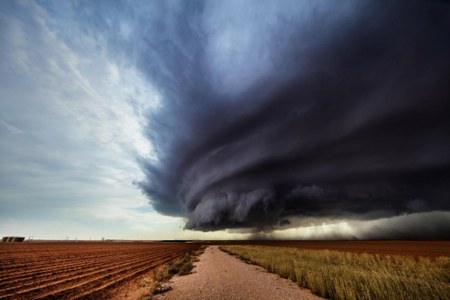Supercells

Source: Natgeo
A supercell is a type of storm characterized by the presence of a rising air stream rotating within the cloud.
Supercell
A thunderstorm with a persistent rotating updraft. Supercells are rare, but are responsible for remarkably high percentage of severe weather events, especially tornadoes, extremely large hailstones and damaging straight-line winds.
https://cloudatlas.wmo.int/glossary.html#G.156
Of the four storm classifications (Supercell, multicellular, unicellular and instability line), supercells are usually the least common, but they are also the most severe.
They can cause heavy rains, electric shocks and wind gusts. But the most dangerous is when tornadoes occur, as they cause a lot of damage wherever they go.
The supercells generally have three classifications: classical, low precipitation and high precipitation. Low-precipitation supercells are found in drier, arid climates, while high-precipitation supercells can arise anywhere in the world, but are seen mainly on the great plains of the United States.
In Brazil they occur mainly in the South and Southeast regions of the country, and eventually produce tornadoes.
Characteristics
Supercells are generally found isolated from other storms.
They occur in the hot part of a low pressure system, usually spreading in line with a cold front of the low pressure system. Because of their duration (several hours), they are practically stable storm systems.
They have rotation due to the slope of the vorticity caused by wind currents. Strong currents make the air that was spinning on a horizontal axis rise and rotate on a vertical axis.
Effects
Supercells can produce strong winds, heavy rainfall with hail, deadly tornadoes, floods and electric shocks.
While tornadoes are perhaps the worst of these severe events, they are all dangerous. Strong downwind winds can reach 148 kilometers per hour and gusts of wind can produce as much damage as a tornado. None of these events are exclusive to supercells, although they are more easily predicted when associated with one of them.
Occurrence
Supercells are more frequent in the great plains of central United States and southern Canada, extending to the southern US and northern Mexico. There has also been registration of supercell formation in central-eastern Argentina and Uruguay, parts of India, South Africa and eastern Australia, eastern China and Europe. Areas with high occurrence of supercells are consequently areas where tornadoes occur.
In Brazil the supercell storms occur mainly in the south and southeast of the country.
